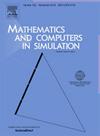Bilinear Bäcklund transformation and soliton solutions to a (3+1)-dimensional coupled nonlinear Schrödinger equation with variable coefficients in optical fibers
IF 4.4
2区 数学
Q1 COMPUTER SCIENCE, INTERDISCIPLINARY APPLICATIONS
引用次数: 0
Abstract
Optical fiber plays a crucial role in modern information and communication technology. The birefringent fiber can allow multiple independent data streams to be transmitted simultaneously in the same fiber, which significantly improves the bandwidth utilization rate of the communication system and has an important impact on the realization of future high-speed, efficient and low-power communication systems. In this paper, with the help of Hirota bilinear method, the (3+1)-dimensional coupled nonlinear Schrödinger equation with variable coefficients is studied carefully, which shows the evolution of two polarization envelopes in birefringent fibers and plays a significant role in the development of optical communications. At the beginning, the bilinear form of the above equation along with bilinear Bäcklund transformation are derived by the Hirota bilinear method. Subsequently, a diverse range of bright–dark alternating soliton solutions, such as U-type, S-type, kink-type and so on, can be constructed by deciding the appropriate special values of the undetermined parameters. It is worthy to note that the above results have never appeared in previous references. The impacts of some parameters on soliton solutions have been discussed and analyzed in detail by comparing the graphs corresponding to multitudinous soliton solutions obtained above. Furthermore, the situations before and after the collision of two solitons in special cases have been studied by using asymptotic analysis.
求助全文
约1分钟内获得全文
求助全文
来源期刊

Mathematics and Computers in Simulation
数学-计算机:跨学科应用
CiteScore
8.90
自引率
4.30%
发文量
335
审稿时长
54 days
期刊介绍:
The aim of the journal is to provide an international forum for the dissemination of up-to-date information in the fields of the mathematics and computers, in particular (but not exclusively) as they apply to the dynamics of systems, their simulation and scientific computation in general. Published material ranges from short, concise research papers to more general tutorial articles.
Mathematics and Computers in Simulation, published monthly, is the official organ of IMACS, the International Association for Mathematics and Computers in Simulation (Formerly AICA). This Association, founded in 1955 and legally incorporated in 1956 is a member of FIACC (the Five International Associations Coordinating Committee), together with IFIP, IFAV, IFORS and IMEKO.
Topics covered by the journal include mathematical tools in:
•The foundations of systems modelling
•Numerical analysis and the development of algorithms for simulation
They also include considerations about computer hardware for simulation and about special software and compilers.
The journal also publishes articles concerned with specific applications of modelling and simulation in science and engineering, with relevant applied mathematics, the general philosophy of systems simulation, and their impact on disciplinary and interdisciplinary research.
The journal includes a Book Review section -- and a "News on IMACS" section that contains a Calendar of future Conferences/Events and other information about the Association.
 求助内容:
求助内容: 应助结果提醒方式:
应助结果提醒方式:


